1930s Girls Fashion Trends 1960s Girls Fashion Trends
Over Seventy Years of Manner History - How Fashions Accept Changed Since the 1920s
It is amazing to meet how the different events in history have influenced and changed the mode people have dressed throughout time. Some of the most popular fashions are classic, they can stand the exam of time and hardly ever "exit of style", merely experiencing minor changes to continue up with the trends. Other vesture items could be considered "fads", styles that are simply pop for a short flavor and then never worn again. Oft sure fashion trends are dependent on the tastes of particular groups of people or cliques and are usually associated with social status or cultural preferences like the blazon of music a person likes. Fashion can also be influenced by world events such every bit war or the economy. For example, during World War II, people were only allowed a certain corporeality of fabric so they were forced to create simple outfits that were practical enough for wartime duties. From the 1920s to the 1990s, popular fashions reflected the mood of each decade and showcased changes in social club every bit the styles of clothing and accessories evolved with the times.
Dresses and Skirts - From Mini to Maxi, Pleats to Pencil
Changes in skirts and dress fashion have changed and varied dramatically between the 1920s to the nowadays, as well every bit within each decade. In 1920, only a few years subsequently Globe War I, brim and wearing apparel hemlines rose and waist lines lowered to the hip. These changes accompanied the boyish flapper fashions that marked the Twenties as a decade of decadence and fun. During 1926 to 1928, hemlines were reported to be at their highest but once the stock market crashed in 1929 and the Great Low fix in, hem lines returned to a more than bourgeois length (below the knee or lower). 1930s boasted a return to femininity and Hollywood glamour was idolized. Evening gowns showed bias-cuts and diamante accents and were made of chiffon or velvet. For a more casual look in the thirties dresses were slim-cut and had wide shoulders and a chugalug around the waist. Real fur accents and floral prints were also popular during this era until World War II broke out and the glamorous look of the decade lost its luster.
During World War 2, luxurious fabrics like wool, silk and nylon were highly regulated and women's skirts and dresses were often made of viscose and rayon. Skirts and dresses would too be made out of anything that could be found within a home (similar curtains, nightgowns or bed sheets) due to the illegality of using excess fabric when making an outfit from almost 1942 to 1947. With the economic blast in the 1950s, glamour become fashionable once once more and A-line and pencil skirts were very pop form-fitting fashions. Dresses in the decade would often characteristic fashionable ruffles or lace accents and were usually knee-length or tea-length. Going into the late fifties and 1960s mini-dresses and maxi-length brim outfits entered the scene. Mod styled dresses with brusk skirts and bold, colorful patterns became popular. Mary Quant, a Mod fashion designer is ane of the people credited with creating the iconic mini-skirt of the mid-sixties. In the belatedly sixties and seventies hippie fashion took over and loose-fitting, flowing maxi skirts and dresses became dominant. Disco music and trip the light fantastic also influenced dresses with slender lines, flowing skirts and the shimmering fabrics that would look all-time in a night club.
As we entered the 1980s, fashion evolved once again. Skirts and dresses were one time once more longer and featured directly lines and more serious blueprint. As more than and more than women joined the professional work force business suits became a tendency for women with straight conservative skirts and broad shouldered, boxy blazers topped the look. In the eighties, fashion became highly influenced past music stars and movies with eclectic looks shown off by Madonna, Cyndi Lauper, and motion picture star Molly Ringwald. In the 1990s, skirts and dresses were not as prominent and more casual looks became acceptable with hip-hop and alternative music setting the scene for fashion early on in the decade. Skirts and dresses were usually short and even provocative, especially in the latter part of the decade, even so loose and flowing dresses also equally long denim skirts were besides notable trends.
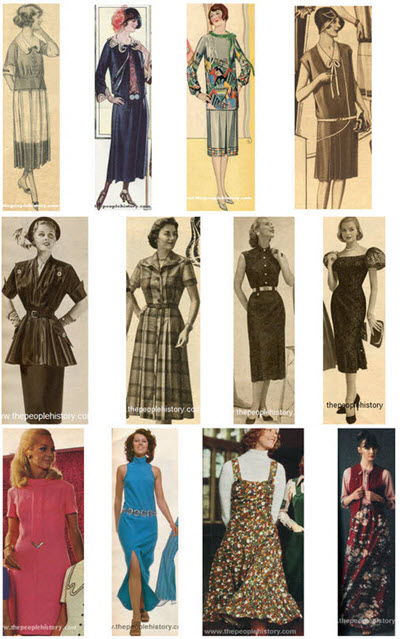
Blouses, Shirts and Tops
In the 1920s, the jumper blouse was introduced and became incredibly popular. Commonly the jumper blouse was fabricated of cotton wool or silk and had a crewman collar. Perfect for pairing with a skirt, it normally reached just below the hips and would be accompanied by a chugalug or sash. Another popular type of twenties blouse was a low-cut v-neck shirt with a chemisette attached to promote modesty. Knitted long-sleeve shirts with rounded collars and tank blouses were also popular in the decade. For men, polo shirts, dress shirts and sweaters were the tops of choice. Going into the thirties, feminine blouses that featured v-necks and long bow ties attached around the cervix, sleeveless blouses and knit shirts of satin and linen were pop. During the war-torn forties nylon and silk were replaced with rayon and viscose for formal tops, while terry fabric, linen and even canvass were used for leisure shirts. Women who worked during World War II wore armed forces style shirts that had button-up collars, and women who were a office of the American Woman's Auxiliary Corps would article of clothing a total war military outfit.
After Earth War II concluded, up until the mid-Fifties trends in women's style changed again. Round-neck styles on sleeveless shirts or long sleeve shirts were pop, besides as polo-necks. Dolman sleeves dominated stylish tops in the fifties and sixties, too. The 1960s brought ethnic print blouses, ribbed turtleneck sweaters and boat-neck tops into mainstream clothing. And, shirts for men and women ofttimes featured "wild" patterns. From the late sixties to the mid-seventies, brightly colored shirts and blouses with psychedelic patterns were trendy and hippie fashion made Indian cheesecloth shirts, peasant tops, tunics and Nehru jackets pop for both men and women of the era. Space-like and futuristic fashions besides became popular and many tops were made out of suede, leather, vinyl and plastic.
In the 1980s, as styles became slightly more coincidental and T-Shirts and polo shirts became acceptable tops, and for formal or business organization-wear, boxy tops with shoulder pads, blazers, dress shirts and sweaters were popular for men and women in the decade. Over-sized tops were popular in the 80s and 90s besides. The 1990'southward saw a lot more commercialization of style with designer labels appearing on the exterior of article of clothing as a mode to promote status and trendiness. That tendency continues today as it is non uncommon to meet people wearing stylish casual shirts that host a assuming Guess or Ralph Lauren logo on the forepart. The nineties as well saw an increase in the popularity of crop tops and halter tops as women's styles became more than provocative. In the belatedly 80s, 90s, and in today's style, T-shirts have go more of a mode to express individuality and a person'southward tastes and preference with sassy grab phrases, funny pictures, or popular culture references appearing more and more in the mainstream.
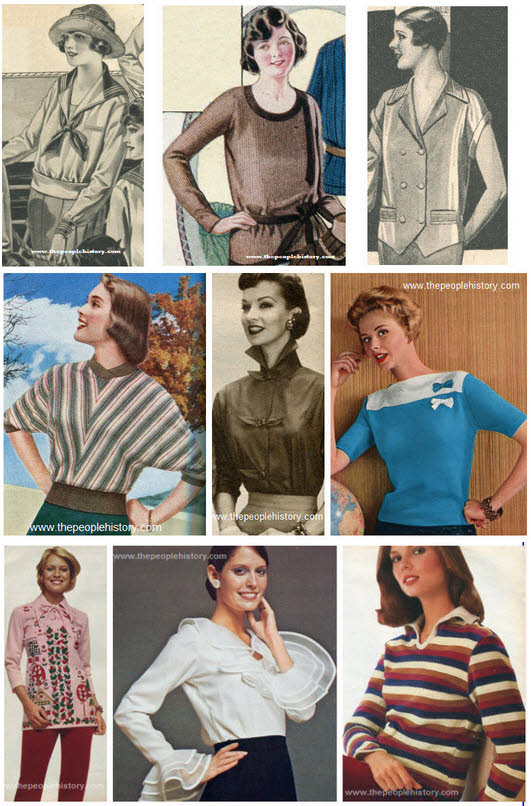
Shoes and Boots
In the 1920s, women's shoes would often characteristic loftier and wide heels whether on a pump or loafer style shoe. Many women would even clothing heeled shoes with their swimming costumes every bit a marking of femininity. Oxfords of varying styles and colors were popular likewise with men and women, every bit well as lace upwardly boots. During the 1930's strapped heels and pumps surged in popularity, while more traditional styles of heels were nevertheless worn. For men and women, laced leather leisure shoes were popular for outdoor activities and do during the decade. In the forties, as a result of the war, shoes became more conservative and practical. Women'south shoes were usually made with flatter heels and had either cork or wooden soles.
Flat shoes, sandals, heels and pumps with rounded toes and feminine lines were worn past women in the 1950s. Saddle shoes, white lace upwards shoes with brown or black leather accents, were as well pop for both men and women. Canvas basketball shoes (high-tops) or black leather oxfords were worn by men. Suede shoes likewise enjoyed moments of popularity during this decade. In the 1960s, black slip-on boots (nigh probable of leather or faux leather material) were popular for men and women, and heels became thinner on pumps. Vinyl boots, moccasin-style loafers with wide heels, wedge heels, and slip-on heels with leather cutting-out patterns were all popular in the 1970s. Sandals and western fashion cowboy boots were besides pop with both men and women.
In the 1980s, pumps were designed with higher and thinner heels than in decades before and they became more of a hit. For coincidental wear, tennis shoes (both high-tops and standard ankle high shoes) and leather dress shoes were very popular. Flats became popular too, peculiarly with working women. By the 1990s, styles had returned to Earth and the casual look was central. During this decade leather substitutes became more than popular due to environmental concerns, and cork-soled sandals similar Birkenstocks defined the alternative look early in the decade. Walking shoes had bulkier heels, and gym-type athletic shoes were nigh people's every twenty-four hours choice. As with the late 1980s and 1990s, branding became a driving forcefulness behind shoe sales. People would evidence off their Reebok, Nike or Adidas shoes with pride and special editions would sell for hundreds of dollars.
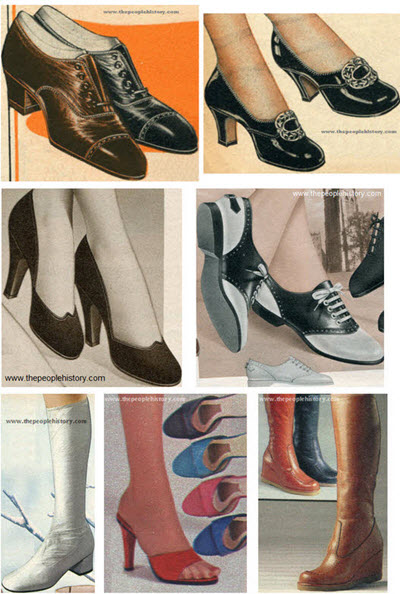
Accessories
From the 1920s to the 1990s, accessories have changed tremendously, just some items like jewelry have always remained pop. Fashionable hats were highly popular from the twenties to the fifties and were often an everyday item in a person's ensemble. For women in the 1920s helmet style, draped hats, cloches, turbans and pokes were all popular and usually featured a diversity of fabrics, cut-outs, lace accents, feathers or other details. In the 30s, 40s, and 50s other styles of women's hats were popular as well with berets, homburgs, bumpers, bonnets, and wider brimmed hats all seeing time in the spotlight.
For men, bow ties and long ties have alternated their turns in the favor of style. From the twenties to the nineties the length, width, cloth, colors and patterns of neck ties have varied according to trends, merely they accept almost always been a necessity for men's business dress and formal wear. Men would wear fedoras, golf caps, machine caps, Panama hats and other about timeless styles of hats up until the seventies, subsequently which hats became less popular as casual styles started to dominate the scene. Baseball caps, skull caps, beanies and other types of casual hats remain pop with men and offer a style to display their favorite sports teams to the earth.
Handbags and purses have also always been pop with women, but the styles have changed throughout the decades. In the twenties and thirties, handbags would oft be used as vanity numberless that featured a congenital-in mirror and could be used to bear on up 1'south make-up and hair while out. In the fifties and sixties handbags became more than of a way statement and would coordinate with the blazon of occasion one was attending, larger, more practical bags were used for shopping or a day out with family while smaller, fancier numberless would be used for parties or fancy evenings out with friends. In the seventies, eighties, and fifty-fifty nineties, handbags and purses became more of a catch-all with women narrowing their collection down to simply 1 or two, a more formal bag and an everyday piece of work type bag. Presently, the blazon of handbags women own take become fifty-fifty more of a status symbol than in the past, with designer bags from Coach, Dooney & Bourke, Fendi, Prada, Michael Kors, Louis Vuitton, Kate Spade, and others costing thousands of dollars beingness the only purses women use, and often the simply luxury slice of habiliment many women own.
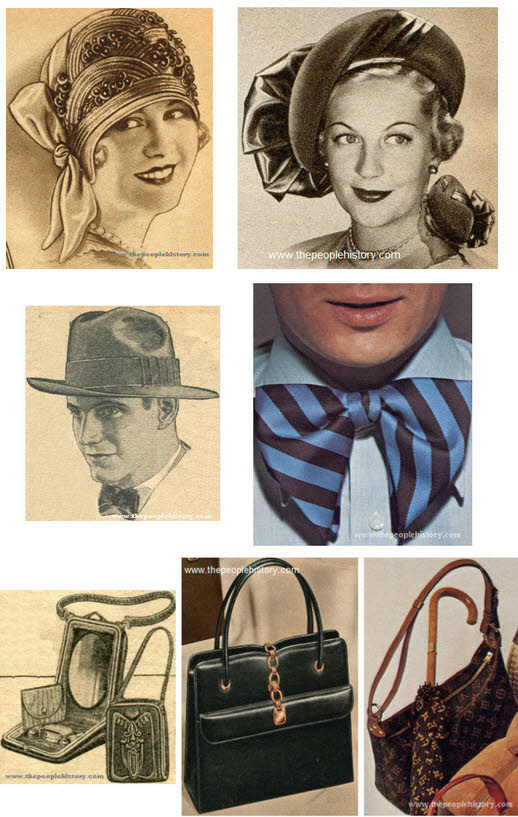
Hairstyles
Short boyish haircuts were popular throughout the 1920s to the late 1930s. In the Forties, hair was often still hid under hats, merely normally was longer and tied in a bun or other upward-exercise. During the Second World War, scarves and turbans were also popular. Hats and turbans (sometimes fifty-fifty worn together) remained popular until the 1960s. After this time women began to perm and/or dye their pilus. Wigs were more than popular afterwards this time likewise, and the wearing of hats declined dramatically. Men'south hair (only like the brusk women's cuts) of the 1920s and 1930s was usually neatly combed and clean-cut, and usually parted to the side. Pilus for men was "greased" back. In the 1950s pilus was still greased dorsum, merely hairstyles usually consisted of more pilus on the peak of the head (specially biker styles). For women in the 1950s, hair was waved and fit to frame the face, or to exist pulled back. Some actresses had wore their hair extremely short-style higher up the ears, as if information technology had been cut with a hair trimmer.
In the 1960s, beehive and flip-style hairdos were more popular for women. For the men, bowl cuts, such as the ones that are similar to what the Beatles wore are very popular as well. These looks continued on to the late 1960s. From the 1970s on, long, straight hair was popular for women, too as for some men. Hairstyles were ordinarily parted downward the middle. Large puffy hair worn by Motown singers were considered stylish from 1969 on to the 1970s, and short wavy hairstyles like Jodie Foster wore in 1976 were popular as well. During the seventies layered haircuts were too pop and this tendency continued into the 1980s. From the mid to late eighties big hairstyles that were teased and curly or wavy with bangs were very popular. In the early 1990s directly hair and long spiral perms became popular, while after in the decade angled bobs and shaggy, mid-length haircuts were made popular by celebrities like Jennifer Aniston and Courteney Cox on the Idiot box prove Friends.
From the 1970s to the electric current time punk hairstyles such as shaved heads, Mohawks, and painted hair were worn. These were usually the hairdos of those who wanted to brand a argument, or just simply to be dissimilar from mainstream guild. Many mainstream and independent artists had punk hairdos. Heavy metal hairstyles for men were quite pop, specially after the 1980s. Male heavy metallic rock groups would tease and/or color their hair, which usually was allow to grow long. There are withal standards for hairstyles in the present. For the workplace hairdos are very conservative, usually in a straight manner, or sometimes waved or slightly permed.
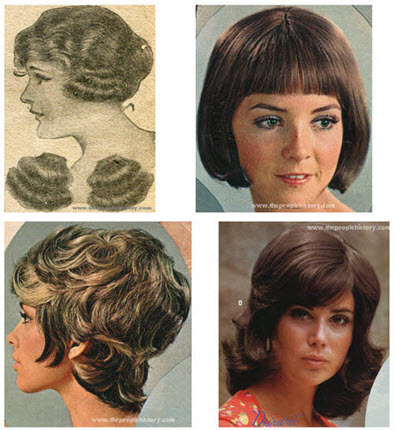
Designer Fashion
Names of designers that were alive during the 1920s and the 1950s include Jeanne Lanvin, "Coco" Chanel, and Pierre Cardin. Each these designers accept set his or her personal mark. For instance, Lanvin is remembered for her intricate trimmings, lavish embroideries, and beaded decorations. These were all implemented in clear, calorie-free fabrics. Chanel is remembered for designing fashions of clothing as if it would be what she would article of clothing. She likewise is known for masculine-cuts and silk blouses. Pierre Cardin is known for items such as his draped stake blue mohair dresses or jacket with fur-trimmed head. Designers from the 1960s include Yves Saint Laurent and Mary Quant. These designers were thought of equally revolutionary way artists. They introduced items such as mini and/or maxi-length dresses, vivid-colored sweater and mini-clothes outfits, and a variety of new accessories such as laced tights likewise as new cosmetics.
With globalization and the massive changes to lodge over the terminal 80 years, manner has inverse to cope with the differences. Designer ranges from modest independent designers to large fashion houses that have existed for several decades. And, while trends still dictate the mode earth, modern designers have often fatigued inspiration from the past and have modified classic looks from the past eighty years to be the height of fashion today. Designers for mass retailers seem to be less focused on creating ground-breaking images in fashion and more focused on adapting popular styles to fit all purposes and body shapes. As nosotros have become more sedentary, our waistlines take expanded and clothing has adapted to that too with more retailers offering larger sizes and more than figure-flattering options.
Men'due south Manner
After World State of war I and until about the twelvemonth 1942 men'due south wear was adequately relaxed and less formal. For example, softer collars were worn during this fourth dimension flow. Sleeveless sport shirts became popular and were worn with white pleated trousers and a belt. Celebrities in the 1920s and 1930s would sometimes combine casual pieces with formal pieces for a new await. Evening wear such as the double-breasted white cotton wool pique was as well worn during these decades, as well as mean solar day suits with wide lapels. These suits were worn with accessories such as wool tie, black trilby hat, or black gloves. Black leather shoes were likewise fabricated pop during this fourth dimension likewise. Wide lapels on men's suits also were very popular in the 1930s with both British and American style suits. Materials used to make these suits were usually a blazon of wool.
Sportswear in between the mid-1930s and 1946 included items such as white straight-leg flannel trousers for tennis playing or nighttime blue elastic-wasted cotton fiber knickers for playing football. A red cloth glaze was sometimes worn with black leather boots for riding. These sportswear outfits were very much influenced by the British. Afterwards 1946, men wore items such as blackness trousers, single-breasted wool jackets, and suits with wide lapels and wide collars. Suit accessories included black bow-ties, black homburg hats, and black shoes. By 1947 the war rations on materials had ended, and so more extravagant men'south habiliment could be made after this fourth dimension. The 1950s British styles were in some ways different than in the 1930s and the 1940s. One of the signature items for men during the kickoff twelvemonth of this decade include the knee-length single breast overcoat (grey-colored) and cuffless sleeves (although cuffless sleeves were sometimes worn in before times). American styles of sports and leisure habiliment that were created in the 1950s included a single-breasted fitted brown jacket, narrow lapels, and flap pockets. These were worn during riding, and perhaps along with knee-high leather riding boots.
During the belatedly sixties and into the late seventies, mode was influenced by designers from numerous countries. For case, Pierre Cardin from France had created a new design of a two-piece grey textile adjust that had a double-breasted long fitted jacket. In the year 1970, the fabric jacket with a zipper was worn equally a 24-hour interval article of clothing outfit. This item was made with large hip-level flap pockets and tight sleeves which flared at the wrists and brownish textile trousers which were besides flared. Leather outfits also became more pop after 1973. Leisure suits and disco-influenced styles were also popular with men in the seventies.
The 1980s was a time of its ain unique style. Men during this time who worked equally an executive or other position of college authority usually wore items such every bit a brown two-pieced double-breasted suit with long narrow lapels. These suits were designed with broad shoulders and shoulder pads. Casual clothing that was significant of the 1980s included denim blueish jeans, often worn with a matching jean jacket. Punk fashion in the 1980s for men included article of clothing items such as sleeveless blackness leather jacket, off-center zip fastening, or flap pockets. In the 1990s bluish jeans were also very popular, but unlike the 1980s, bell-bottoms, wider-legged and baggy pants were in style. Black polo neck sweaters were popular in the year 1995, equally well every bit 2-slice wool striped suits with pocket-sized collar and narrow ankle-length trousers.
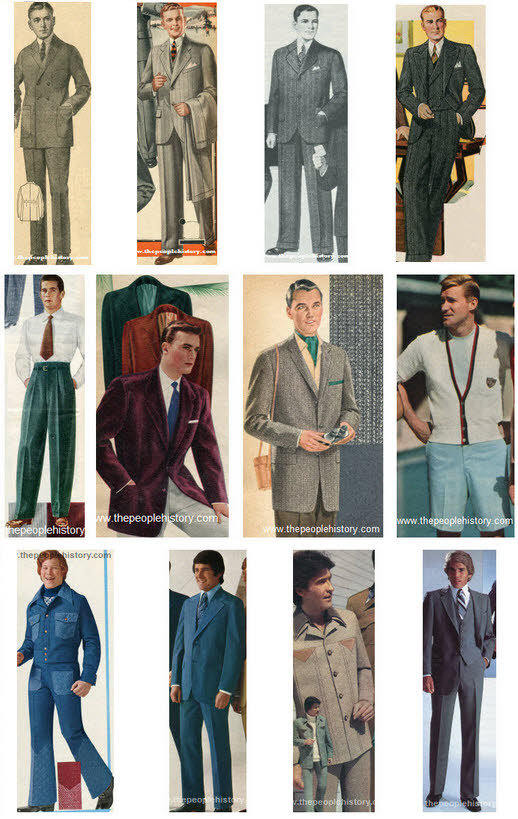
Teenage Fashion
From the 1920s to the 1940s teen apparel was adequately conservative in contrast to nowadays-day styles. For the about part teens dressed very much similar the adults of this time. In the 1920s teens wore outfits such every bit the schoolgirl buck fashion outfit which consisted of a gathered skirt with a hemline just below the knee. This skirt was usually accompanied by a V-necked bottom-downwards jersey knit cardigan, white collared shirt, and necktie, all topped with a beret lid. Other teen girls and older children often wore cardigan sweaters, cotton fiber frocks, and canvass shoes. Sometimes they wore sandals with their outfits. In the 1930s teens and/or young women would dress to imitate movie stars as much as possible.
In the 1940s, during World State of war II, natural materials for clothing were scarce. During this time, wearing apparel were mended when worn and when new clothes were needed drapes, sheets, pillow cases, and other household materials were used to brand new clothes. During the 1950s, new teen fashions began to develop, especially betwixt 1955 and 1960. In fact, this was the period of time when teens began to purchase their ain clothing, which was ane of the reasons why they became such an influence on article of clothing that was made during this time. Teen girls in the mid to late 1950s wore article of clothing items such as an oversized sweater, buttoned cardigan, and a simple long tweed brim. Effectually their necks they sometimes wore a string of beads along with it or a patterned fashionable scarf. Also in the fifties, groups of teen girls also sometimes wore baseball jackets and loose jeans rolled upwardly.
During the sixties, mini-skirts and mini-dresses became very popular. During the belatedly 1960s long flowing "hippie" dresses were sometimes worn by teens or young women. These styles along with jeans and T-shirts and psychedelic clothing were besides very popular with youth, peculiarly those at to the lowest degree 18. This trend continued on throughout the 1970s, which also included the wearing of bell-bottoms. The 1970s was considered to be all well-nigh individual expression and clothing definitely reflected that. In the eighties, overalls, sweat suits, Spandex sportswear, cotton wool jersey dresses, and baseball shirts were often worn by teens. Additionally, parachute pants, jeans (direct-legged or narrow-cut), sneakers, and denim shirts or jackets.
Teen styles from the 1990s had many more variations than in decades before. Equally in the 1970s, trends from this time on became more well-nigh private expression for teens rather than post-obit a trend, and as a result, numerous sub-groups, frequently called "cliques" were formed. From the 1990s to the present twenty-four hours, one grouping of teens may wear the usual jeans and T-shirt outfit and other groups, such as punks, habiliment ripped jeans, spiked or colored hair, and body piercings. In the present 24-hour interval, teen vesture has also go quite risque, although manner professionals frown upon certain trends. Overall, clothing is much more coincidental and relaxed for teens than in times past. Many teens are not required to wear school uniforms at all, unless attending a individual school.
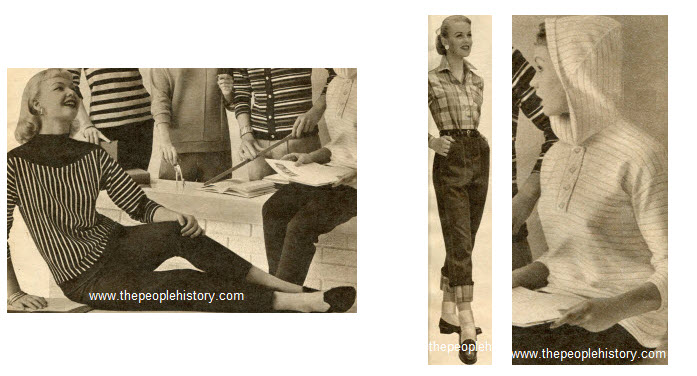
Children's Manner
Toddler girls from 1919 wore laced-edged rompers which snapped on the sides. A bloomer dress with white neckband was worn in the year 1925, and a fringed bunting with side fasteners was used to continue babies warm in the year 1939. Older girls wore schoolgirl outfits such equally a black or light-green velveteen plaid skirt with white pique blouse and feather white socks and white shoed in the belatedly thirties. A polka dot sun arrange with elastic around edges of pinnacle and shorts was a big hit in the 1950s. This outfit was most probable worn every bit a swimsuit. Center-aged boys in the 1920s wore items such as a gray or brown woolen suit jacket with matching belong and trousers. From this fourth dimension throughout the 1930s different styles of knickers (knee pants) were worn by boys likewise. Sometimes knickers were worn with human knee-high print socks and shoes.
Older boys wore wool slacks and five-necked jacquard patterned sweaters in the 1950s. Likewise in the 1950s, boys wore navy denim jeans with a checked cotton button-down, collared shirt. In the 1960s, outfits for school and sports became more coincidental. Ane of the simple signature outfits of this decade was the black and white washable Welsh wool dress. In afterwards years, these dresses were then made from homo-fabricated materials. Gingham skirts were displayed in an Issue of Vogue during this decade besides, which means these dresses were most probable worn quite a chip. In the year 1964 boys often wore a wool blazer and grey shorts. During this fourth dimension, both boys and girls wore short white socks when they were young and human knee-length socks when older. These socks were oftentimes held up by garter belts.
Toddlers in the 1960s were often seen in pinafore rompers. These were oftentimes worn over a blouse or jersey. From 1965 to 1970, outfits such equally the machine-washable slumber adjust were worn by babies, and this outfit was considered to be ane of the most useful habiliment items upward to this time period. For the small boy during the late 1960s and early 1970s, a tweed coat with long trousers-similar to the 1950s boys outfits-is worn with a stiffened woolen hat. Girls during this time dressed much like the women of the time, in high-waist dresses and matching ribbed tights. In the 1970s, girls wore a multifariousness of different kind of outfits like to what women wore, such as Indian impress shirts. They also wore print silky outfits of a matching shirt and flared pants.
The 1980s is the starting time of some other evolution in children'south wearable. Girls during this decade wore outfits such as the unisex poly-cotton brushed leisure suit. Small boys during this decade wore outfits such equally a suit with a bright blue meridian that has red sleeves with logo on chest, forth with pants to friction match. Other children's outfits worn during this time include girls' dresses in bluish and white, with vest-shaped meridian and gathered short brim. This was oft worn with accessories such as heart-shaped sunglasses, canvass sandals, and hair tied upward with bright stretchy bands. The nineties school and summer fashions were made for children to be able to move and play in. A signature boys' outfit of this fourth dimension is the blue jeans overall outfit, and the girls' signature outfit is the jean dress with a white trim and pink shirt underneath. Clothes from the 1990s for children share a like vein as to the ones in the nowadays day. The about important aspect of making wear for children today is to make certain the outfits are safe to wear and that they fit well.
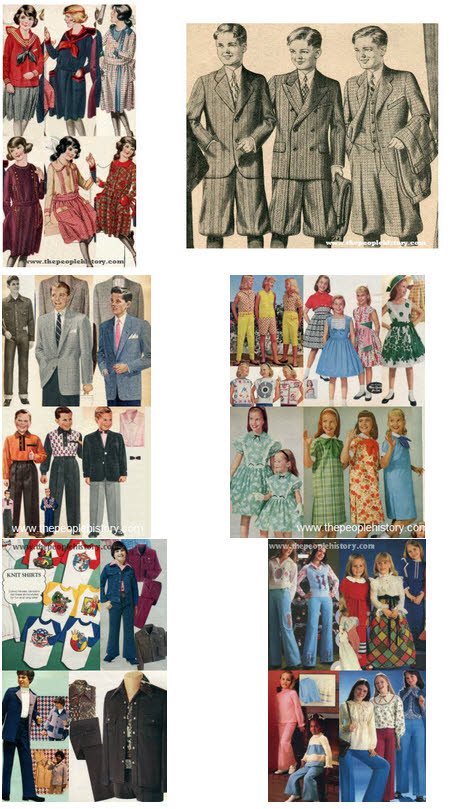
0 Response to "1930s Girls Fashion Trends 1960s Girls Fashion Trends"
Post a Comment